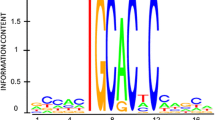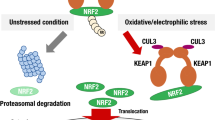Abstract
MTF-1 is a crucial transcription factor involved in the cellular response to heavy-metal load and other stresses by specifically binding to metal response elements (MREs). Thus far only a handful of direct target genes are known for this transcription factor, limiting our understanding of the biological network it governs. In this article we try to employ a computational strategy based on the generation of literature-based positional weight matrices (PWM) and log-likelihood scoring of the candidate binding sites (BSs) for identification of direct targets of the transcription factor MTF-1 in human and mouse. Through comparisons, we explore the conservation and unique characteristics between two species. Our results show that the numbers of MREs differ dramatically between species and their positions relative to their cognate promoter is also flexible. Importantly, we identify a set of target genes generally well conserved between human and mouse. Finally, by combining expression analysis we provide two putative targets (HMGCR and CYP51A), which regulate lipid metabolism conserved in human and mouse. Overall, interspecies comparison from our study may provide some valuable information for further studying human Wilson disease (WD) using mouse model systems.







Similar content being viewed by others
References
Andrews GK (2000) Regulation of metallothionein gene expression by oxidative stress and metal ions. Biochem Pharmacol 59:95–104
Andrews GK (2001) Cellular zinc sensors: MTF-1 regulation of gene expression. Biometals 14:223–237
Bailey TL, Williams N, Misleh C, Li WW (2006) MEME: discovering and analyzing DNA and protein sequence motifs. Nucleic Acids Res 34:W369–W373
Bieda M, Xu X, Singer MA, Green R, Farnham PJ (2006) Unbiased location analysis of E2F1-binding sites suggests a widespread role for E2F1 in the human genome. Genome Res 16:595–605
Brooksbank C, Camon E, Harris MA, Magrane M, Martin MJ et al (2003) The European bioinformatics institute’s data resources. Nucleic Acids Res 31:43–50
Carroll JS, Liu XS, Brodsky AS, Li W, Meyer CA et al (2005) Chromosome-wide mapping of estrogen receptor binding reveals long-range regulation requiring the forkhead protein FoxA1. Cell 122:33–43
Cawley S, Bekiranov S, Ng HH, Kapranov P, Sekinger EA et al (2004) Unbiased mapping of transcription factor binding sites along human chromosomes 21 and 22 points to widespread regulation of noncoding RNAs. Cell 116:499–509
Chen X, Chu M, Giedroc DP (1999) MRE-binding transcription factor-1: weak zinc-binding finger domains 5 and 6 modulate the structure, affinity, and specificity of the metal-response element complex. Biochemistry 38:12915–12925
Cheung T, Kwan Y, Hamady M, Liu X (2006) Unraveling transcriptional control and cis-regulatory codes using the software suite GeneACT. Genome Biol 7:R97
Collas P, Dahl JA (2008) Chop it, ChIP it, check it: the current status of chromatin immunoprecipitation. Front Biosci 13:929
Culotta VC, Hamer DH (1989) Fine mapping of a mouse metallothionein gene metal response element. Mol Cell Biol 9:1376–1380
Dalton TP, Li Q, Bittel D, Liang L, Andrews GK (1996) Oxidative stress activates metal-responsive transcription factor-1 binding activity. Occupancy in vivo of metal response elements in the metallothionein-I gene promoter. J Biol Chem 271:26233–26241
Frith MC, Fu Y, Yu L, Chen JF, Hansen U et al (2004) Detection of functional DNA motifs via statistical over-representation. Nucleic Acids Res 32:1372–1381
Gompel N, Prud’homme B, Wittkopp PJ, Kassner VA, Carroll SB (2005) Chance caught on the wing: cis-regulatory evolution and the origin of pigment patterns in Drosophila. Nature 433:481–487
Green CJ, Lichtlen P, Huynh NT, Yanovsky M, Laderoute KR et al (2001) Placenta growth factor gene expression is induced by hypoxia in fibroblasts: a central role for metal transcription factor-1. Cancer Res 61:2696–2703
Gunes C, Heuchel R, Georgiev O, Muller KH, Lichtlen P et al (1998) Embryonic lethality and liver degeneration in mice lacking the metal-responsive transcriptional activator MTF-1. EMBO J 17:2846–2854
Gupta M, Liu JS (2005) De novo cis-regulatory module elicitation for eukaryotic genomes. Proc Natl Acad Sci USA 102:7079–7084
Hestand MS, van Galen M, Villerius MP, van Ommen GJ, den Dunnen JT et al (2008) CORE_TF: a user-friendly interface to identify evolutionary conserved transcription factor binding sites in sets of co-regulated genes. BMC Bioinformatics 9:495
Heuchel R, Radtke F, Georgiev O, Stark G, Aguet M et al (1994) The transcription factor MTF-1 is essential for basal and heavy metal-induced metallothionein gene expression. EMBO J 13:2870
Hogstrand C, Zheng D, Feeney G, Cunningham P, Kille P (2008) Zinc-controlled gene expression by metal-regulatory transcription factor 1 (MTF1) in a model vertebrate, the zebrafish. Biochem Soc Trans 36:1252–1257
Huster D, Purnat TD, Burkhead JL, Ralle M, Fiehn O et al (2007) High copper selectively alters lipid metabolism and cell cycle machinery in the mouse model of Wilson disease. J Biol Chem 282:8343–8355
Johnson R, Gamblin RJ, Ooi L, Bruce AW, Donaldson IJ et al (2006) Identification of the REST regulon reveals extensive transposable element-mediated binding site duplication. Nucleic Acids Res 34:3862–3877
Koizumi S, Suzuki K, Ogra Y, Yamada H, Otsuka F (1999) Transcriptional activity and regulatory protein binding of metal-responsive elements of the human metallothionein-IIA gene. Eur J Biochem 259:635–642
Langmade SJ, Ravindra R, Daniels PJ, Andrews GK (2000) The transcription factor MTF-1 mediates metal regulation of the mouse ZnT1 gene. J Biol Chem 275:34803–34809
Lee KE, Nam S, Cho EA, Seong I, Limb JK et al (2008) Identification of direct regulatory targets of the transcription factor Sox10 based on function and conservation. BMC Genomics 9:408
Lichtlen P, Wang Y, Belser T, Georgiev O, Certa U et al (2001) Target gene search for the metal-responsive transcription factor MTF-1. Nucleic Acids Res 29:1514–1523
Muller P, van Bakel H, van de Sluis B, Holstege F, Wijmenga C et al (2007) Gene expression profiling of liver cells after copper overload in vivo and in vitro reveals new copper-regulated genes. J Biol Inorg Chem 12:495–507
Murphy BJ, Andrews GK, Bittel D, Discher DJ, McCue J et al (1999) Activation of metallothionein gene expression by hypoxia involves metal response elements and metal transcription factor-1. Cancer Res 59:1315–1322
Murphy BJ, Sato BG, Dalton TP, Laderoute KR (2005) The metal-responsive transcription factor-1 contributes to HIF-1 activation during hypoxic stress. Biochem Biophys Res Commun 337:860–867
Nemec AA, Leikauf GD, Pitt BR, Wasserloos KJ, Barchowsky A (2009) Nickel mobilizes intracellular zinc to induce metallothionein in human airway epithelial cells. Am J Respir Cell Mol Biol 41:69–75
Nishimoto F, Sakata M, Minekawa R, Okamoto Y, Miyake A et al (2009) Metal transcription factor-1 is involved in hypoxia-dependent regulation of placenta growth factor in trophoblast-derived cells. Endocrinology 150:1801
Prud’homme B, Gompel N, Carroll SB (2007) Emerging principles of regulatory evolution. Proc Natl Acad Sci USA 104 Suppl 1:8605–8612
Pruitt KD, Maglott DR (2001) RefSeq and LocusLink: NCBI gene-centered resources. Nucleic Acids Res 29:137–140
Smith AD, Sumazin P, Xuan Z, Zhang MQ (2006) DNA motifs in human and mouse proximal promoters predict tissue-specific expression. Proc Natl Acad Sci USA 103:6275–6280
Song MO, Li J, Freedman JH (2009) Physiological and toxicological transcriptome changes in HepG2 cells exposed to copper. Physiol Genomics 38:386–401
Stuart GW, Searle PF, Chen HY, Brinster RL, Palmiter RD (1984) A 12-base-pair DNA motif that is repeated several times in metallothionein gene promoters confers metal regulation to a heterologous gene. Proc Natl Acad Sci USA 81:7318–7322
Stuart GW, Searle PF, Palmiter RD (1985) Identification of multiple metal regulatory elements in mouse metallothionein-I promoter by assaying synthetic sequences. Nature 317:828–831
Svensson PA, Englund MC, Markstrom E, Ohlsson BG, Jernas M et al (2003) Copper induces the expression of cholesterogenic genes in human macrophages. Atherosclerosis 169:71–76
Vallania F, Schiavone D, Dewilde S, Pupo E, Garbay S et al (2009) Genome-wide discovery of functional transcription factor binding sites by comparative genomics: the case of Stat3. Proc Natl Acad Sci USA 106:5117–5122
Wang T, Furey TS, Connelly JJ, Ji S, Nelson S et al (2009) A general integrative genomic feature transcription factor binding site prediction method applied to analysis of USF1 binding in cardiovascular disease. Hum Genomics 3:221–235
Wimmer U, Wang Y, Georgiev O, Schaffner W (2005) Two major branches of anti-cadmium defense in the mouse: MTF-1/metallothioneins and glutathione. Nucleic Acids Res 33:5715–5727
Wray GA (2007) The evolutionary significance of cis-regulatory mutations. Nat Rev Genet 8:206–216
Zhang X, Odom DT, Koo SH, Conkright MD, Canettieri G et al (2005) Genome-wide analysis of cAMP-response element binding protein occupancy, phosphorylation, and target gene activation in human tissues. Proc Natl Acad Sci USA 102:4459–4464
Zhou Q, Wong WH (2004) CisModule: de novo discovery of cis-regulatory modules by hierarchical mixture modeling. Proc Natl Acad Sci USA 101:12114–12119
Zhou C, Zhou F, Xu Y (2009) Comparative analyses of distributions and functions of Z-DNA in Arabidopsis and rice. Genomics 93:383–391
Zhu Z, Shendure J, Church GM (2005) Discovering functional transcription-factor combinations in the human cell cycle. Genome Res 15:848–855
Zweig MH, Campbell G (1993) Receiver-operating characteristic (ROC) plots: a fundamental evaluation tool in clinical medicine. Clin Chem 39:561–577
Acknowledgments
The authors express their gratitude to the members of the Animal Sciences Laboratory of Shanghai Jiao Tong University. This work was supported by the National Key Technology R&D Program (grant No. 2008BADB2B11), National High Technology Research and Development Program of China (863) (grant Nos. 2008AA101002, 2008AA101009, 2006AA10Z1E3), the National Key Basic Research Program (973) (grant No. 2006CB102102), and the National Natural Science Foundation of China (grant Nos. 30671492 and 30871782).
Author information
Authors and Affiliations
Corresponding authors
Electronic supplementary material
Below is the link to the electronic supplementary material.
Rights and permissions
About this article
Cite this article
Wang, M., Yang, F., Zhang, X. et al. Comparative analysis of MTF-1 binding sites between human and mouse. Mamm Genome 21, 287–298 (2010). https://doi.org/10.1007/s00335-010-9257-7
Received:
Accepted:
Published:
Issue Date:
DOI: https://doi.org/10.1007/s00335-010-9257-7




